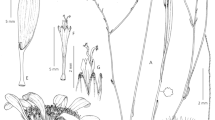Abstract
This paper documents the occurrence of the genus Umbilicaria in the neighbourhood of Admiralty Bay on King George Island in the maritime Antarctic. Nine species are reported from the area surveyed, with Umbilicaria kappeni being reported from King George Island for the first time. The occurrence of U. aprina, U. cristata and U. umbilicarioides on the island is confirmed and that of U. aprina is its first documented record from the maritime Antarctic. Fertile specimens of U. umbilicarioides are recorded for the first time from Antarctica. The area around Admiralty Bay seems to be one of the Antarctic regions with the highest diversity of Umbilicaria species. The diagnostic characters and distribution of each species are discussed. An updated key for identification of all the Antarctic species of the genus is provided.





Similar content being viewed by others
References
Andreev MP (1988a) De lichenoflora Paeninsulae Fildes Insulae King-George (Antarctis) notula. Novitates Systematicae Plantorum non Vasculariun 25:111–118
Andreev MP (1988b) De lichenoflora Insulae King-George (Antarctis) notula. Novitates Systematicae Plantorum non Vasculariun 25:118–124
Castello M (2003) Lichens of the Terra Nova Bay area, Northern Victoria Land (Continental Antarctica). Stud Geobot 22:3–54
Castello M, Nimis PL (2000) A key to the lichens of Terra Nova Bay (Victoria Land, Continental Antarctica). Ital J Zool 1 [Suppl]:175–184
Convey P, Lewis Smith RI, Peat HJ, Pugh PJA (2000) The terrestrial biota of Charcot Island, eastern Bellingshausen Sea, Antarctica: an example of extreme isolation. Antarct Sci 12:406–413
Dodge CW (1973) Lichen flora of the Antarctic Continent and adjacent islands. Phoenix, Canaan
Dodge CW, Baker GE (1938) The second Byrd Antarctic Expedition—Botany. II. Lichens and lichen parasites. Ann Mo Bot Gard 25:515–718
Filson RB (1987) Studies in Antarctic lichens 6: further notes on Umbilicaria. Muelleria 6:335–347
Hestmark G (1990) Thalloconidia in the genus Umbilicaria. Nord J Bot 9:547–574
Jacobsen P, Kappen L (1988) Lichens from the Admiralty Bay region, King George Island (South Shetland Islands, Antarctica). Nova Hedwigia 46:503–510
Kejna M (1999) Air temperature on King George Island, South Shetland Islands, Antarctica. Pol Polar Res 20:183–201
Krog H, Swinscow TDV (1986) The lichen genera Lasallia and Umbilicaria in East Africa. Nord J Bot 6:75–85
Krzewicka B (2004) The lichen genera Lasallia and Umbilicaria in the Polish Tatra Mts. Pol Bot Stud 17:1–88
Krzewicka B, Osyczka P (2002) Umbilicaria aprina Nyl: a new lichen species from central Europe. Acta Soc Bot Pol 71:171–174
Lindsay DC (1969) New records for Antarctic Umbilicariaceae. Br Antarct Surv Bull 21:61–69
Llano GA (1950) A monograph of the lichen family Umbilicariaceae in the Western Hemisphere. Office of Naval Research, Washington DC
Llano GA (1966) A new species of Umbilicaria. Bryologist 69:109–111
Ochyra R (1998) The moss flora of King George Island, Antarctica. W. Szafer Institute of Botany, Polish Academy of Sciences, Cracow
Olech M (1989a) Lichens from the Admiralty Bay region, King George Island (South Shetland Islands, Antarctica). Acta Soc Bot Pol 58:493–512
Olech M (1989b) Preliminary botanical studies in Johnsons Dock area (Livingston, Antarctica). Bull Pol Acad Sci Biol Sci 37:223–230
Olech M (1994) Lichenological assessment of the Cape Lions Rump, King George Island, South Shetland Islands; a baseline for monitoring biological changes. Pol Polar Res 15:111–130
Olech M (2001) Annotated checklist of Antarctic lichens and lichenicolous fungi. Institute of Botany, Jagiellonian University, Cracow
Øvstedal DO, Lewis Smith RI (2001) Lichens of Antarctica and South Georgia: a guide to their identification and ecology. Cambridge University Press, Cambridge
Poelt J, Nash TH III (1993) Studies in the Umbilicaria vellea group (Umbilicariaceae) in North America. Bryologist 96:422–430
Rakusa-Suszczewski S (ed) (1993) The maritime Antarctic coastal ecosystem of Admiralty Bay. Dep Antarctic Biology, Polish Academy of Sciences, Warsaw
Rakusa-Suszczewski S (2003) Functioning of the geoecosystem for the West side of Admiralty Bay (King George Island, Antarctica): outline of research at Arctowski Station. Ocean Polar Res 25:653–662
Redón JF (1985) Liquenes Antarcticos. Instituto Antartico Chileno, Santiago
Sancho LG, Kappen L, Schroeter B (1992) The lichen genus Umbilicaria on Livingston Island, South Shetland Islands, Antarctica. Antarct Sci 4:189–196
Sancho LG, Schroeter B, Valladares F (1998) Umbilicaria kappeni (Umbilicariaceae) a new lichen species from Antarctica with multiple mechanisms for the simultaneous dispersal of both symbionts. Nova Hedwigia 67:279–288
Sancho LG, Schulz F, Schroeter B, Kappen L (1999) Bryophyte and lichen flora of South Bay (Livingston Island: South Shetland Islands, Antarctica). Nova Hedwigia 68:301–337
Acknowledgements
The authors would like to thank Leopoldo G. Sancho for taxonomic consultations, the curators of TSB, AAS and GZU herbaria for kindly lending us specimens of U. saviczii and U. thamnodes for study, Adam Wincenciak who took the photographs, and Lucyna Śliwa, Renata Malejki, Arthur Copping (Roydon, Diss, UK) and three anonymous reviewers for their valuable suggestions and constructive comments on the manuscript. The authors especially wish to thank Lucyna Śliwa whose inspiration and invaluable advice initiated and developed their interest in the fascinating world of lichens. The authors also owe thanks to Maria Olech for suggesting that they undertake Antarctic lichenological research and for her cooperation during their PhD studies. Special thanks are also due to all the XX and XXVI “Arctowski” expeditionary teams, particularly the leaders of those expeditions, Adam Barcikowski and Paweł Loro, for logistical aid and comradeship during field studies. The field survey was made possible by the logistical and financial support of the Department of Antarctic Biology, Polish Academy of Sciences. This work was also partly supported by the State Committee for Scientific Research grants nos. 6P04F01820 and 2P04F00127.
Author information
Authors and Affiliations
Corresponding author
Rights and permissions
About this article
Cite this article
Krzewicka, B., Smykla, J. The lichen genus Umbilicaria from the neighbourhood of Admiralty Bay (King George Island, maritime Antarctic), with a proposed new key to all Antarctic taxa. Polar Biol 28, 15–25 (2004). https://doi.org/10.1007/s00300-004-0638-9
Received:
Revised:
Accepted:
Published:
Issue Date:
DOI: https://doi.org/10.1007/s00300-004-0638-9




